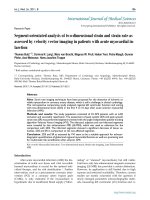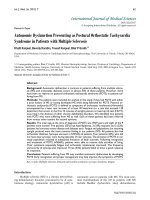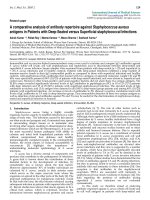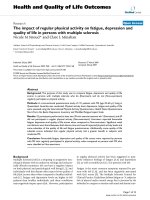Báo cáo y học: " Autonomic Dysfunction Presenting as Postural Orthostatic Tachycardia Syndrome in Patients with Multiple Sclerosis"
Bạn đang xem bản rút gọn của tài liệu. Xem và tải ngay bản đầy đủ của tài liệu tại đây (169.82 KB, 6 trang )
Int. J. Med. Sci. 2010, 7
62
I
I
n
n
t
t
e
e
r
r
n
n
a
a
t
t
i
i
o
o
n
n
a
a
l
l
J
J
o
o
u
u
r
r
n
n
a
a
l
l
o
o
f
f
M
M
e
e
d
d
i
i
c
c
a
a
l
l
S
S
c
c
i
i
e
e
n
n
c
c
e
e
s
s
2010; 7(2):62-67
© Ivyspring International Publisher. All rights reserved
Research Paper
Autonomic Dysfunction Presenting as Postural Orthostatic Tachycardia
Syndrome in Patients with Multiple Sclerosis
Khalil Kanjwal, Beverly Karabin, Yousuf Kanjwal, Blair P Grubb
Department of Medicine, Division of Cardiology Section of Electrophysiology, The University of Toledo, Toledo, OH 43614,
USA.
Corresponding author: Blair P Grubb, MD, Director Electrophysiology Services, Division of Cardiology, Department of
Medicine, Health Sciences Campus, University of Toledo Medical Center, Mail Stop 1118, 3000 Arlington Ave., Toledo OH
43614. USA. Phone 419-3833778; Fax: 419-383-3041.
Received: 2010.03.01; Accepted: 2010.03.10; Published: 2010.03.11
Abstract
Background: Autonomic dysfunction is common in patients suffering from multiple sclero-
sis (MS) and orthostatic dizziness occurs in almost 50% of these patients. However, there
have been no reports on postural orthostatic tachycardia syndrome (POTS) in patients suf-
fering from MS.
Methods: The patients were included for analysis in this study if they had POTS with either
a prior history of MS or having developed MS while being followed for POTS. Postural or-
thostatic tachycardia (POTS) is defined as symptoms of orthostatic intolerance(>6months)
accompanied by a heart rate increase of at least 30 beats/min (or a rate that exceeds 120
beats/min) that occurs in the first 10 minutes of upright posture or head up tilt test (HUTT)
occurring in the absence of other chronic debilitating disorders. We identified nine patients
with POTS who were suffering from MS as well. Each of these patients had been referred
from various other centers for second opinions.
Results: The mean age at the time of diagnosis of POTS was 49±9 years and eight of the 9
patients were women. Five patients (55%) had hyperlipidemia, 3 (33%) migraine and 2 (22%)
patients had coronary artery disease and diabetes each. Fatigue and palpitations (on assuming
upright posture) were the most common finding in our patients (9/9). All patients also had
orthostatic dizziness. Syncope was seen in 5/9(55%) of patients. Four patients (44%), who did
not have clear syncope, were having episodes of near syncope. The presence of POTS in our
study population resulted in substantial limitation of daily activities. Following recognition
and treatment of POTS, 6/9(66%), patients were able to resume daily activities of living.
Their symptoms (especially fatigue and orthostatic intolerance) improved. The frequency
and severity of syncope also improved. Three (33%) patients failed to show a good response
to treatment.
Conclusion: Patients suffering from MS may manifest autonomic dysfunction by developing
POTS. Early recognition and proper management may help improve the symptoms of POTS.
Key words: Multiple sclerosis, Postural tachycardia syndrome, syncope, dizziness, fatigue.
Introduction
Multiple sclerosis (MS) is a chronic demyelinat-
ing inflammatory disorder, presumed to be of auto-
immune etiology. Autonomic dysfunction (AD) is
commonly seen in patients with MS. The most com-
mon manifestations of the AD in patients with MS
include bladder dysfunction, sleep disturabances,
Int. J. Med. Sci. 2010, 7
63
sweating, gastrointestinal and cardiovascular distur-
bances. Another common symptom seen in patients of
MS is fatigue. Orthostatic dizziness (OD) has been
reported to occur in up to 50% of MS patients (1-4).
Autonomic dysfunction has an important impact on
the disability that patients with MS experience and
can substantially restrict the activities of daily living
in these individuals.
Autonomic dysfunction in patients with MS is
felt to occur because of involvement of several critical
pathways of autonomic nervous system, including the
brain stem, spinal cord, hypothalamus and cerebral
cortex. Demyelinating plaques may disrupt reflex
pathways in the insular, cingulated and ventromedial
prefrontal cortices, central nucleus of the amygdala,
paraventricular hypothalamus and the medulla. In
addition there can be interference with the descending
autonomic nervous system pathways during their
course in the brainstem or spinal cord (6). Although
orthostatic dizziness has been commonly seen in pa-
tients of MS, to date there have been no studies or
reports on the occurrence of postural orthostatic
tachycardia syndrome (POTS) in patients with MS.
We report on a series of nine MS patients with POTS.
Methods
The study was a retrospective descriptive analy-
sis of the patients followed up at the University of
Toledo Autonomic Disorder Center. The study was
approved by our Institutional Review Board. The data
of these patients had been collected from1998-2008.
Nine patients were identified that were included in
the analysis. These patients were initially seen else-
where and were seen in our clinic for second opinions.
All but two patients were diagnosed with multiple
sclerosis. The diagnosis of MS was based on clinical
history, neurological examination and supported by
cerebrospinal fluid analysis and Magnetic Resonance
Imaging of the brain in each case. Two patients with
POTS, who were followed at our clinic, developed
multiple sclerosis after being diagnosed with POTS.
Criterion for diagnosis of POTS: The diagnosis of
POTS was based on clinical history, clinical examina-
tion and a positive (POTS pattern) head up tilt test
(HUTT). The HUTT criterion for diagnosing POTS
was an absolute heart rate >120 bpm or an increase by
> 30bpm within the first ten minutes of an upright tilt.
We did not routinely evaluate catecholamine levels in
any of these patients.
A neurologist followed each of these patients
and close contacts were maintained between our cen-
ter and the patients’ neurologist. The patients’ neu-
rological and autonomic center data (charts and/or
physician letters) were then carefully reviewed for
demographic characteristics, comorbid conditions,
symptoms of MS, symptoms of POTS, medications
and response to medication. The data obtained are
presented as mean ± standard deviation or as per-
centages where applicable.
Response to therapy
Response to therapy was subjectively assessed in
each patient. None of the patients underwent a repeat
HUTT test for objective assessment of symptom re-
sponse to therapy. The therapy was considered suc-
cessful if it provided symptom relief.
Results
Nine patients with POTS who either had a prior
history of MS or developed MS were identified for
inclusion in the study. The mean age at the time of
diagnosis was 49±9 years and 8 of the 9 patients were
women. All the patients were Caucasians. All patients
were being followed by a neurologist who specialized
in MS. The results are summarized in Table 1.
Comorbidity
Five patients (55%) had hyperlipidemia, 3 (33%)
migraine and 2 (22%) patients had coronary artery
disease and diabetes each.
Symptoms of POTS
Fatigue and palpitations (on assuming upright
posture) were the most common finding in our pa-
tients (9/9). All patients also had orthostatic dizzi-
ness. Syncope was seen in 5/9(55%) of patients. Four
patients (44%), who did not have frank syncope, were
having episodes of near syncope. Each patient had
experienced symptoms for greater than six months.
Head up Tilt Test (HUTT): All nine patients un-
derwent HUTT. All patients demonstrated either an
absolute heart rate of >120bpm or an increase of >
30bpm within the first ten minutes of an upright tilt.
All patients demonstrated symptoms of orthostatic
intolerance similar to that reported during their
spontaneous episodes. None of the patients had a
resting heart rate > 100 bpm. We did not evaluate
catecholamine levels in any of these patients.
Symptoms of Multiple Sclerosis
Visual disturbances in the form of episodic blur-
ring of vision were seen in 4/9(44%) patients. Sensory
disturbances including numbness, tingling, pins and
needles sensation in extremities were seen in
4/9(44%) patients. Gait problems (leg and/or arm
weakness) were also seen in 4/9(44%) patients. Sei-
zures were seen in two (22%) patients. Two (22%)
Int. J. Med. Sci. 2010, 7
64
patients had recurrent bladder symptoms in form of
incontinence and retention. Another two (22%) had
been having excessive sweating.
Table 1: Clinical characteristics of the patients of Multiple
Sclerosis and orthostatic intolerance.
Characteristics Values
Age(years) 49±9
Race (Caucasians %) 100
Sex (Females) 8/9 (89%)
Comorbid Condition
Hyperlipidemia 5/9 (55%)
Migraine 3/9 (33%)
Coronary artery disease 2/9 (22%)
Diabetes 2/9 (22%)
Symptoms of POTS
Fatigue 9/9 (77%)
Dizziness/Near Syncope 9/9(100%)
Palpitation 9/9(55%)
Syncope 5/9(55%)
Symptoms of Multiple Sclerosis
Visual Disturbances(optic neuritis) 4/9(44%)
Gait Problem/ Weakness 4/9 (44%)
Sensory disturbances 4/9 (44%)
Urinary Symptoms 2/9(22%)
Seizures 2/9 (22%)
Medications
SSRI 7/9(77%)
Pyridostigmine 6/9(66%)
Midodrine 4/9 (45%)
Betablockers 3/9(33%)
Fludrocortisone 2/7(22%)
Modefinil 1/9(11%)
Combination 5/9(55%)
Onset of POTS in relation to Multiple
Sclerosis(MS)
Followed MS 7/9(77%)
Preceded MS 2/9(22%)
Response of POTS symptoms to medical
therapy
Successful 6/9(66%)
Failure 3/9(33%)
Number of patients requiring Pacemaker 2/9(22%)
Onset of POTS in relation to MS
Two patients developed POTS prior to diagnosis
of MS. One of these patient developed POTS three
years, and another, one and a half years before the
onset of MS. Seven (77%) patients’ developed POTS
over a mean period of (22 months) from the diagnosis
of the multiple sclerosis.
Daily activities and lifestyle in our study patients
Each of the patients reported a constant fear of
experiencing syncope. This fear had greatly limited
their daily activities to a point that they were scared of
assuming an upright posture and had become home
bound. One patient had a recurrent feeling of a sense
of impending doom.
Medications
Treatment aimed at minimizing symptoms was
initiated in each patient following the diagnosis of
POTS. The majority of these patients were on selective
serotonin reuptake inhibitors (venlafaxine and du-
loxetine
)
(7/9, 77%). Six (66%) patients were on pyri-
dostigmine, 4(44%) on midodrine, 3(33%) on
beta-blockers (propranolol), 2 (22%) on fludrocorti-
sone and one (11%) on modafinil. Five (55%) patients
were receiving a combination of one of these medica-
tions.
Response to Medical therapy
The therapeutic management approach for these
patients was based on our previous experience with
the management of patients with POTS. Initial ther-
apy consisted of an increase in salt and fluid intake as
well as aerobic reconditioning with resistance training
to increase lower extremity strength. Pharmacother-
apy was used alone or in combination in the following
order: fludrocortisone 0.1mg po bid, midodrine 5-10
mg po tid, propanolol10 mg po tid, pyrodostigmine
60 mg po bid, serotonin reuptake inhibitor or modaf-
inil 100 mg po qam. Not every patient received every
medication. Following recognition and treatment of
POTS, 6/9(66%) patients were able to engage in daily
activities of living. Fatigue and orthostatic intolerance
were the symptoms which improved most. The fre-
quency and severity of syncope also improved sig-
nificantly. Three (33%) patients failed to demonstrate
a good response to medical therapy and continued to
experience recurrent syncope. Two out of these three
patients had convulsive activity without prodrome
during syncope. These two patients were further in-
vestigated by placement of an implantable loop re-
corder and were found to have periods of prolonged
asystole during their episodes of syncope felt to be
neurocardiogenic in nature. Thus these two patients
had MS with POTS as well as episodes of neurocar-
diogenic syncope. Both of them received a dual
chamber pacemaker. Following pacing one patient
experienced complete elimination of syncope while
the other experienced a significant reduction in fre-
quency and severity of her events. Another patient
did not show a good response to therapy and contin-
ues to have episodes of orthostatic dizziness and
syncope.
Int. J. Med. Sci. 2010, 7
65
Discussion
POTS is defined as an excessive increase in heart
rate associated with symptoms of more than 6
months’ duration (in the absence of other conditions
that could mimic this such as dehydration and de-
conditioning). In POTS, the heart rate increases 30
beats per minute (or exceeds 120 beats per minute)
within the first 10 minutes of standing or HUTT. More
complete descriptions of the diagnosis and manage-
ment of POTS are given elsewhere (7-11). Multiple
sclerosis (MS) is an autoimmune inflammatory de-
myelinating disease of the central nervous system
(CNS) that is a leading cause of disability in young
adults.
Autonomic dysfunction is commonly seen in
patients with MS (1-5). In patients of MS, autonomic
dysfunction (AD) has been thought to be related to
involvement of reflex pathways in the brainstem (12).
Both decreased heart rate variability and de-
creased blood pressure response in tilt table testing
occur as a result of AD in patients with MS (12-16). On
cardiovascular reflex testing it has been shown that
both sympathetic as well as parasympathetic dys-
function can occur in patients with MS (12-16). Re-
duced heart rate variability and vasomotor dysfunc-
tion in MS appears to correlate with the degree of
plaque burden seen on MRI in the midbrain areas,
also with the presence of hemispherical lesions (17).
Autonomic regulatory abnormalities are thought to
occur due to involvement of central autonomic inter-
connections (18). In a study of carotid baroreflex in
MS patients the baroreflex dysfunction involved both
cardiovagal limb of the baroreflex as well the sym-
pathetic modulation of blood vessels (19). In addition,
impaired sympathetic nervous system mediated
vasomotor control may result in orthostatic intoler-
ance and dizziness that is seen in almost 50% of MS
patients (20). Autonomic cardiovascular dysfunction
may progress over time as was shown in a report by
Nasseri et al. (21, 22). Sympathetic vasomotor dys-
function may also contribute to fatigue in patients
with MS (23). As has been noticed previously the
majority of our patients were females. Both POTS and
MS occur more commonly in women of childbearing
age. All of our patients were of Caucasian descent.
Symptoms of POTS and MS
The most common symptom in our study
population was fatigue. Fatigue is a characteristic
finding in MS, usually described as physical exhaus-
tion that is unrelated to the amount of activity per-
formed. Many patients complain of feeling exhausted
on waking, even if they have slept soundly. Fatigue
can also occur during the day but may be only par-
tially relieved by rest. In addition, there appears to be
a correlation between fatigue and disrupted sleep in
MS patients. In our patients, we were not able to ob-
tain any information about their sleep habits. Despite
being a common symptom of MS there has been no
correlation between fatigue and the overall severity of
disease (24-26). All of our patients had orthostatic
intolerance. Fifty percent patients of POTS have been
reported to have orthostatic dizziness in various
studies. Syncope which is uncommon in MS patients
occurred in almost 5/9(55%) of patients in this study.
Increase in cerebrovascular resistance occurring dur-
ing orthostatic stress can explain loss of consciousness
in these patients (27). In two patients the episodes of
syncope were associated with prolonged periods of
asystole felt to be neurocardiogenic in origin. Postural
orthostatic tachycardia with asystole has been re-
ported during HUTT testing (28). In addition to fa-
tigue our patients also presented with episodic visual
disturbances (blurring of vision, optic neuritis), ex-
tremity weakness and sensory abnormalities like
numbness and tingling. Seizures which occur usually
in 2-3% (29) of MS patients were seen in 2/9 (22%) of
patient in this selected cohort. This high incidence of
seizure, syncope and asystole in this series might be
due to the selection bias in this small group of pa-
tients.
Management of POTS in patients with MS
The pharmacological management of POTS in
patients of MS was similar to that in patients without
a history of MS. In our small group of patients, six
patients showed a good response to a combination of
medications (Table 1). Two patients who had recur-
rent episodes of abrupt onset syncope with convulsive
activity were found to have periods of prolonged
asystole on implantable loop recorder (ILR) monitor-
ing and subsequently received a pacemaker. In one of
these patients, her episodes of syncope were elimi-
nated whereas in another, the episodes now have a
prodrome and have decreased in severity and fre-
quency. Patients who have abrupt onset syncope with
convulsive activity might have prolonged episodes of
bradycardia or an asystole as a cause for their syncope
(30, 31).
Another patient continues to experience palpita-
tions and episodes of syncope and has failed multiple
medications when used either alone or in combina-
tion. Interestingly two (22%) patients in our series had
an onset of POTS prior to the diagnosis of MS while
seven (77%) developed POTS over months to years
following diagnosis of MS. It is difficult at this time to
predict which POTS patients could develop MS, or
which MS patients could develop POTS during the
Int. J. Med. Sci. 2010, 7
66
progression of their disease.
Daily activities and lifestyle in our study patients
MS is a debilitating disease and the concurrent
diagnosis of POTS in our study population has re-
sulted in substantial limitation of daily activities.
POTS can have tremendous effect on the quality of life
often resulting in severe limitation of daily activities;
in addition, an often neglected but nonetheless im-
portant aspect of this disorder is the tremendous so-
cial, economical and emotional toll it takes on the pa-
tients but also on their families.
POTS, when it occurs in patients of MS can add
to the morbidity and disability these patients are al-
ready suffering from. As seen in our patient popula-
tion recognition and management of POTS in patients
of MS may result in improved quality of life.
Limitations
Our study was a single center, retrospective and
nonrandomized descriptive analysis of a small num-
ber of patients, which predisposed it to an inherent
selection bias. One of the major limitations of this
study was the manner in which the patients were in-
cluded in this small study. These patients had accu-
mulated over years and had been referred from mul-
tiple centers for second opinion. Thus it was difficult
to determine the incidence of POTS in MS patients
based on the analysis of this small population. There
was no age matched control group of MS patients
without POTS. This study reviewed the subjective
reports on the symptoms of POTS in MS patient. The
nature of the severity of symptom improvement
and/or worsening with medication was again subjec-
tive and not assessed by a response to HUTT. These
limitations do not influence our conclusion that POTS
can occur in patients with MS.
Conclusion
Autonomic dysfunction in the form of POTS can
occur in MS patients.
Conflict of Interest
The authors have declared that no conflict of in-
terest exists.
References
1. Anema JR, Heijenbrok MW, Faes TJ, Heimans JJ, Lanting P,
Polman CH. Cardiovascular autonomic function in mul-tiple
sclerosis. J Neurol Sci 1991;104:129–134.
2. Frontoni M, Fiorini M, Strano S, Cerutti S, Giubilei F, Urani C,
Bastianello S, Pozzilli C. Power spectrum analysis con-tribution
to the detection of cardiovascular dysautonomia in multiple
sclerosis. Acta Neurol Scand 1996;93:241–245.
3. Linden D, Diehl RR, Berlit P. Subclinical autonomic
dis-turbances in multiple sclerosis. J Neurol 1995;242:374– 378.
4. Vita G, Fazio MC, Milone S, Blandino A, Salvi L, Messina C.
Cardiovascular autonomic dysfunction in multiple scle-rosis is
likely related to brainstem lesions. J Neurol Sci 1993;120: 82–86.
5. Acevedo AR,Nava C, Arriada N, Violante A, Corona T. Car-
diovascular dysfunction in multiple sclerosis. Acta Neurol
Scand 2000;101:85–88.
6. Vita G, Fazio MC, Milone S, Blandino A, Salvi L, Messina C.
Cardiovascular autonomic dysfunction in multiple scle-rosis is
likely related to brainstem lesions. J Neurol Sci 1993;120:82–86.
7. Sandroni P, Opfer-Gehrking TL, McPhee BR, Low PA. Postural
tachycardia syndrome: Clinical features and follow-up study.
Mayo Clin Proc 1999; 74:1106–1110
8. Grubb BP, Kanjwal Y, Kosinski DJ. The postural orthostatic
tachycardia syndrome: Current concepts in pathophysiology,
diagnosis, and management. J Interv Card Electrophysiol 2001;
5:9–16.
9. Grubb BP, Kosinkski DJ. Syncope resulting form autonomic
insufficiency syndromes associated with orthostatic in-
toler-ance. Med Clin North Am 2001; 85:457–472.
10. Kanjwal Y, Kosinski D, Grubb BP. The postural orthostatic
tachycardia Syndrome: Definitions, diagnosis, and man-
age-ment. Pacing Clin Electrophysiol 2003; 26:1747–1757.
11. Grubb BP, Kanjwal Y, Kosinski DJ. The postural tachycardia
syndrome: A concise guide to diagnosis and management. J
Interv Card Electrophysiol 2006; 17:108–112.
12. Acevedo AR,Nava C, Arriada N, Violante A, Corona T. Car-
diovascular dysfunction in multiple sclerosis. Acta Neurol
Scand 2000;101:85–88
13. Linden D, Diehl RR, Berlit P. Subclinical autonomic
dis-turbances in multiple sclerosis. J Neurol 1995;242:374– 378
14. Nordenbo AM, Boesen F, Andersen EB. Cardiovascular auto-
nomic function in multiple sclerosis. J Auton Nerv Syst
1989;26:77–84
15. Pentland B, Ewing DJ. Cardiovascular reflexes in multiple
sclerosis. Eur Neurol 1987;26:46–50.
16. Pomeranz B, Macaulay RJ, Caudill MA, Kutz I, Adam D,
Gordon D, Kilborn KM, Barger AC, Shannon DC, Cohen RJ, et
al. Assessment of autonomic function in humans by heart rate
spectral analysis. Am J Physiol 1985;248:H151–153.
17. Saari A, Tolonen U, Paakko E, Suominen K, Pyhtinen J,
So-taniemi K, Myllyla V. Cardiovascular autonomic
dys-function correlates with brain MRI lesion load in MS. Clin
Neurophysiol 2004;115:1473–1478.
18. Thomaides TN, Zoukos Y, Chaudhuri KR, Mathias CJ. Physio-
logical assessment of aspects of autonomic function in patients
with secondary progressive multiple sclerosis. J Neurol
1993;240:139–143.
19. Sanya EO, Tutaj M, Brown CM,Goel N, Neundorfer B,Hilz MJ.
Abnormal heart rate and blood pressure responses to baroreflex
stimulation in multiple sclerosis patients. Clin Auton Res
2005;15:213–218.
20. Vita G, Fazio MC, Milone S, Blandino A, Salvi L, Messina C.
Cardiovascular autonomic dysfunction in multiple scle-rosis is
likely related to brainstem lesions. J Neurol Sci 1993;120:82–86.
21. Nasseri K, TenVoorde BJ,Ader HJ, Uitdehaag BM, Polman CH.
Longitudinal follow-up of cardiovascular reflex tests in multi-
ple sclerosis. J Neurol Sci 1998;155:50–54
22. Nasseri K, Uitdehaag BM, van Walderveen MA, Ader HJ, Pol-
man CH. . Cardiovascular autonomic function in pa-tients with
relapsing remitting multiple sclerosis: a new surro-gate marker
of disease evolution? Eur J Neurol 1999;6:29–33.
23. Flachenecker P, Rufer A, Bihler I, Hippel C, Reiners K, Toyka
KV, Kesselring J. Fatigue in MS is related to sympathetic
vasomotor dysfunction. Neurology 2003;61:851–853.
24. Attarian, HP, Brown, KM, Duntley, SP, et al. The relationship of
sleep disturbances and fatigue in multiple sclerosis. Arch
Neurol 2004; 61:525.









